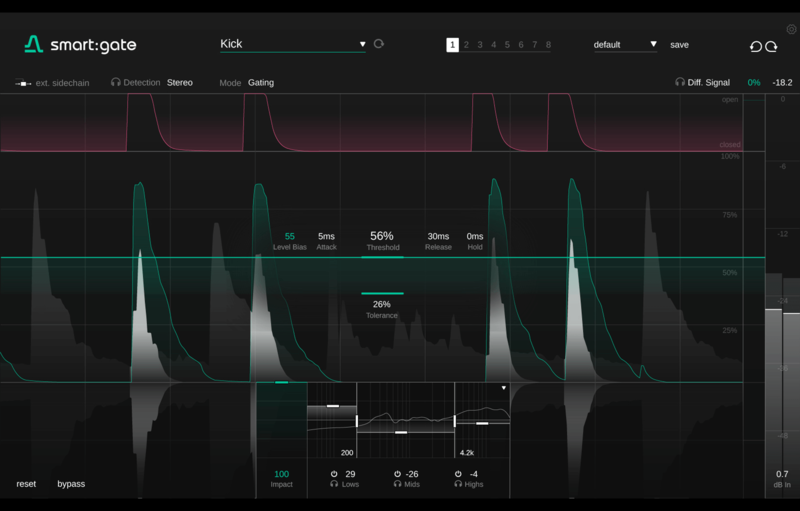smart:gate is the answer to reliable gating.
The plug-in automatically detects the presence of a chosen target source (e.g. vocals, keys, kick) and allows to focus on this source when gating. Unlike conventional gates, smart:gate does not open or close depending on the overall level of the input signal, but it only reacts to signal components belonging to the target. This content-awareness helps to make the gate much more stable and easier to parametrize than conventional gates and it even allows to use the gate, if some background signal occasionally exceeds the level of the target source.
Now for the first time, gating can be as simple as selecting a target source from a drop-down menu. Whether you’re targeting vocals, electric guitar, piano or a suite of other options, the result is a gate that delivers reliably even if a target source varies in level, or if a competing instrument is louder than the signal you want to keep.
Simple Setup, Powerful Control
smart:gate’s visualizer traces the level of the detected target signal, not the entire input signal, making parametrization straightforward and faster. With sonible’s ‘Instant Replay’, when you change a parameter, the visualized signal changes the whole signal history, predicting the impact on the entire signal.
With Level Bias, the gating behavior can follow the detected signal more or less closely – great for refining the response on transient material like drums, or keeping non-transient material like vocalsmore natural. You can also use smart:gate without its content-aware AI features, for operation as a conventional gate.
Gating response can be customized further with the ‘Impact control’, which scales back the amount of gain reduction applied when the gate is closed. smart:gate also offers a Ducking mode to reduce the target signal instead of passing it through. A three-band suppression network helps to weight gating across the frequency spectrum.
Going For The Signal Source
Gating can be a tricky task – with smart:gate, it’s as simple as selecting a target source from a drop-down menu. Whether you’re targeting vocals, electric guitar, piano or one of many other options, the intelligent gate reliably delivers even when the target source varies in level, or a competing instrument is louder than the signal you want to keep. smart:gate’s content-aware processing unlocks its full power where conventional gate plug-ins struggle.
Insights For Faster Workflows
Finally, a gate that is truly able to differentiate between a mix and the signal component contained within it. Both the target signal’s activity and the gating are visualized in detail. Together with Instant Replay, you are provided with all the insights you need to get your parametrization and tweaking done much faster – all with familiar controls and without any guesswork.
Intuitive Interface Packed With Great Features
Besides its intelligent target source detection, smart:gate sports a host of features for fine-tuning, such as a three-band suppression network for weighting the gating across the frequency spectrum. The level bias enables you to increase the level-dependency of the processing – extremely handy when you want refine the response to transient target sources. And, since gating and ducking are closely related in their processing, the gate plug-in can be switched to ducking mode, offering you the same target-focused functionality. You can also use smart:gate without its content-aware AI features as a conventional gate.
Features
- Content-aware gate processing
- Wide range of instrument and sound profiles to determine the target source
- Familiar control over gating response: Threshold, Attack/Release, Hold, Tolerance
- Visual guidance on target source detection for easier parametrization
- ‘Instant replay’ prediction after parameter changes
- With ‘No Target’, conventional, non-AI gating is still possible
- Content-aware ducking mode to reduce selected target signal
- Tailor gating across the frequency spectrum with three-band suppression control
- External sidechain input; detection in mono/mid or side signals
- Available Formats: AAX, VST, VST3 and AU
- Apple Silicon: native support for M1 and M2 chips (including AAX)
Mac
- macOS 10.13+ (M1 Apple Silicon supported) (64-bit only)
- RAM – at least 4 GB (recommended)
- CPU – at least Intel DualCore i5 (recommended)
- Plugin Formats – AU, VST2, VST3, AAX, MultiRack Native
- Supported Sample Rates – 44.1 kHz to 192 kHz
PC
- Windows 10+ (64-bit only)
- RAM – at least 4 GB (recommended)
- CPU – at least Intel DualCore i5 (recommended)
- Plugin Formats – VST2, VST3, AAX, MultiRack Native
- Supported Sample Rates – 44.1 kHz to 192 kHz
Compatible DAW’s:
- Logic Pro
- Ableton Live
- Pro Tools 11+
- Reaper
- Cubase
- Nuendo
- FL Studio
- Studio One



















